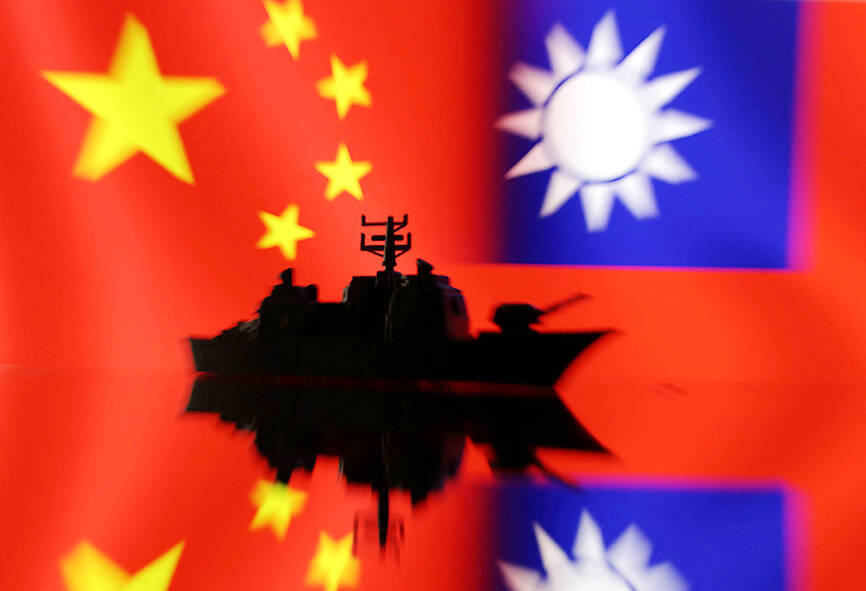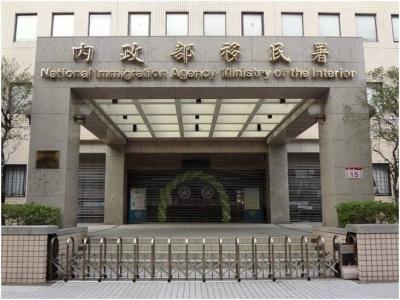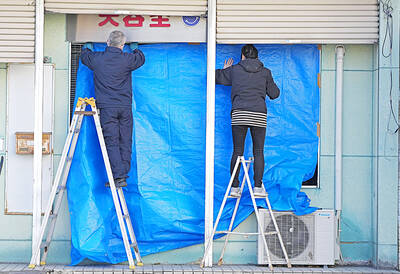China is rehearsing for a potential invasion of Taiwan using a shadow navy of civilian cargo ships and ferries, according to a Reuters investigation that tracked vessel movements and analyzed satellite imagery of military exercises conducted this summer.
The investigation reveals that the Chinese People’s Liberation Army (PLA) is experimenting with techniques that could accelerate the landing of troops and equipment onto multiple Taiwanese beaches simultaneously — a strategy that military experts say aims to overwhelm the nation’s defenders.
Twelve civilian vessels were identified — six roll-on, roll-off car ferries and six deck cargo ships — as they traveled in mid-August to a beach near Jiesheng in Guangdong Province. Satellite images captured some of the ships practicing beach landing operations on Aug. 23.

Photo: Reuters
Satellite images show deck cargo ships unloading vehicles directly onto beaches using their vehicle ramps.
Reuters is the first to publish images of this strategy during an amphibious landing exercise.
These civilian vessels, about 90m long and widely used in Asian commercial shipping, can deliver cargo to beaches without port facilities due to their shallow draft and open-deck design.
The exercises featured a self-propelled floating pier system that has not been seen since 2023, suggesting that China continues to develop portable infrastructure that could speed the unloading of troops, equipment and supplies if Taiwanese infrastructure is unavailable or destroyed during an invasion, according to naval warfare experts.
The outcome of a Chinese attack could depend heavily on the response of the US, the nation’s most important ally.
For decades, the US refused to say how it would react to an invasion, a policy dubbed “strategic ambiguity.”
Former US president Joe Biden appeared to break with this policy, confirming on a number of occasions during his term that US forces would defend Taiwan if it was attacked.
Asked about US President Donald Trump’s position on Taiwan, a White House spokesman said: “The policy of the US is to maintain Taiwan’s defensive capability relative to that of China. And as the president has said, Chairman Xi Jinping (習近平) will not attack Taiwan while President Trump is in office.”
“The Taiwan question is purely an internal affair of China, and how to resolve it is entirely a matter for the Chinese people,” the Chinese Ministry of Foreign Affairs said in response to questions.
The Chinese Ministry of National Defense did not respond to a request for comment.
In response to questions, Taiwan’s Ministry of National Defense referred Reuters to comments made in September by Minister of National Defense Wellington Koo (顧立雄), who said that Taiwan maintains “continuous oversight” of China’s use of roll-on, roll-off vessels.
“We closely monitor how they support military operations,” Koo said, adding that Taiwan has “developed relevant contingency plans.”
Admiral Lee Hsi-min (李喜明), a former chief of staff of Taiwan’s armed forces, said the satellite imagery shows that China is developing capabilities for “multi-point, small amphibious landing operations” using large numbers of smaller craft.
This approach could prove more difficult for Taiwan to defend against than concentrated landings at fewer sites, he said.
Use of civilian vessels could greatly expand China’s capacity for amphibious landings.
The Chinese military has dedicated military ships capable of transporting about 20,000 troops in an initial attack, according to Taiwanese and US military experts.
That is far short of military experts’ estimates of what would be needed in an invasion. Subduing Taiwan would require 300,000 to 1 million troops or more, they said, making civilian vessels crucial to any invasion plan.
Getting large numbers of armored vehicles ashore quickly in particular is critical.
At one point during the August exercise, Reuters counted at least 330 vehicles that had accumulated on and near the beach.
Reuters spent about a year tracking more than 100 civilian vessels that have participated in past military drills or that are owned by operators frequently involved in military exercises.
The news agency worked with satellite data provider BlackSky Technology to observe the summer drills.
China’s commercial shipbuilding industry accounts for 53 percent of global shipbuilding, compared with just 0.1 percent for the US.
The PLA has legal authority to commandeer civilian shipping for military purposes, giving China enormous amphibious lift capability beyond its already formidable navy — the world’s largest.
“It means that their amphibious lift capability is much, much greater than what it appears to be,” said Ian Easton, an associate professor at the US Naval War College, who reviewed the exercise imagery.
One senior Taiwan defense official, who requested anonymity due to the sensitivity of the matter, questioned the viability of using civilian ferries and cargo ships in an invasion.
The official said it would be nearly impossible for China to deploy landing craft like the ones Reuters observed during an invasion, because they would be vulnerable to small, easily-portable weapons such as shoulder-fired missiles.
The official suggested China might be waging “cognitive warfare” by holding large-scale exercises designed to demoralize Taiwan and its allies.

A small number of Taiwanese this year lost their citizenship rights after traveling in China and obtaining a one-time Chinese passport to cross the border into Russia, a source said today. The people signed up through Chinese travel agencies for tours of neighboring Russia with companies claiming they could obtain Russian visas and fast-track border clearance, the source said on condition of anonymity. The travelers were actually issued one-time-use Chinese passports, they said. Taiwanese are prohibited from holding a Chinese passport or household registration. If found to have a Chinese ID, they may lose their resident status under Article 9-1

Taiwanese were praised for their composure after a video filmed by Taiwanese tourists capturing the moment a magnitude 7.5 earthquake struck Japan’s Aomori Prefecture went viral on social media. The video shows a hotel room shaking violently amid Monday’s quake, with objects falling to the ground. Two Taiwanese began filming with their mobile phones, while two others held the sides of a TV to prevent it from falling. When the shaking stopped, the pair calmly took down the TV and laid it flat on a tatami mat, the video shows. The video also captured the group talking about the safety of their companions bathing

PROBLEMATIC APP: Citing more than 1,000 fraud cases, the government is taking the app down for a year, but opposition voices are calling it censorship Chinese Nationalist Party (KMT) Chairwoman Cheng Li-wun (鄭麗文) yesterday decried a government plan to suspend access to Chinese social media platform Xiaohongshu (小紅書) for one year as censorship, while the Presidential Office backed the plan. The Ministry of the Interior on Thursday cited security risks and accusations that the Instagram-like app, known as Rednote in English, had figured in more than 1,700 fraud cases since last year. The company, which has about 3 million users in Taiwan, has not yet responded to requests for comment. “Many people online are already asking ‘How to climb over the firewall to access Xiaohongshu,’” Cheng posted on

A classified Pentagon-produced, multiyear assessment — the Overmatch brief — highlighted unreported Chinese capabilities to destroy US military assets and identified US supply chain choke points, painting a disturbing picture of waning US military might, a New York Times editorial published on Monday said. US Secretary of Defense Pete Hegseth’s comments in November last year that “we lose every time” in Pentagon-conducted war games pitting the US against China further highlighted the uncertainty about the US’ capability to intervene in the event of a Chinese invasion of Taiwan. “It shows the Pentagon’s overreliance on expensive, vulnerable weapons as adversaries field cheap, technologically